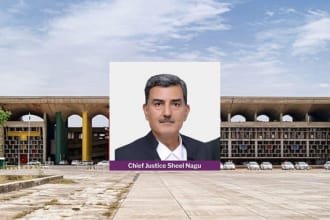As tensions flare between India and Pakistan, the Punjab and Haryana High Court Bar Association (HCBA) has stepped forward with a crucial appeal to the Chief Justice of the High Court, Justice Sheel Nagu. In a letter dated May 10, 2025, HCBA Secretary Gagandeep Jammu formally requested that video conferencing (VC) be declared the preferred mode of judicial proceedings, citing growing concerns about safety amid potential airstrikes and drone attacks across Punjab.
This development comes in the backdrop of heightened security threats in northern India, particularly in border regions. The city of Chandigarh, which houses the Punjab and Haryana High Court, has reportedly seen fighter jets patrolling its skies through the night. As a result, the legal community is grappling with concerns about the continuation of court operations in a manner that does not jeopardize lives.
War-like Situation Raises Alarms
The letter submitted by HCBA paints a stark picture. It outlines how the ongoing geopolitical tensions have directly impacted the safety and movement of advocates and litigants. Gagandeep Jammu writes that intercity travel restrictions, night blackouts, and drone attacks in cities like Pathankot, Gurdaspur, Jalandhar, and Ferozepur have left little room for normal functioning of the justice delivery system.
He emphasizes that while the courts must continue functioning to uphold justice, physical hearings must be curtailed to minimize risk. The association has advocated for virtual hearings to become the norm, at least temporarily, until the situation stabilizes.
Key Demands by the Bar Association
In its communication to Chief Justice Sheel Nagu, the HCBA outlined a four-point safety protocol to guide the High Court’s functioning in the coming days:
1. Restriction on Physical Attendance
The Bar Association has called for temporary restrictions on the physical presence of litigants, clients, and non-essential personnel inside the court premises. Only in cases of absolute necessity should in-person hearings be conducted.
This measure is intended to reduce footfall and potential chaos in the event of sudden emergencies, such as air-raid alerts or evacuation orders.
2. Promotion of Video Conferencing as the Default Mode
Noting that all courtrooms are already equipped with video conferencing tools, the Bar has suggested that courts shift to VC as the default method of hearing. This will enable lawyers and parties to attend proceedings from the safety of their homes or offices.
Interestingly, the HCBA pointed out that VC hearings are currently allowed only on request, and some benches permit them only during fixed hours. The Association believes that in light of the crisis, such restrictions must be lifted, and VC should be universally accessible.
3. Emergency Exit Planning
Given the unique architectural layout of the High Court building, the Association has proposed the circulation of emergency evacuation maps. These maps should be accompanied by simulation videos, helping all stakeholders—advocates, staff, and clients—prepare for any emergency evacuation protocols.
Such planning is essential in reducing panic and disorder in high-stress situations such as air raid warnings or drone threats.
4. Implementation of Standard Operating Procedures (SOPs)
The Bar has proposed regular safety training and mock drills for court staff and legal professionals. Designated exit routes for lawyers, identification of emergency assembly points, and the setting up of communication lines during emergencies are key components of the proposed SOPs.
These drills aim to prevent stampedes and ensure that even in the event of sudden threats, the court premises can be cleared swiftly and safely.
Tension with the Chief Justice
The Bar’s communication also responds to concerns raised by Chief Justice Sheel Nagu, who had earlier criticized the HCBA’s “No Work” call on May 9. During the hearing of a critical inter-state water dispute case, Justice Nagu reportedly remarked:
“The ‘No Work Call’ was a little unfortunate. When the forces are fighting the battle, you will be sitting at home and resting? That is very unfortunate.”
In reply, the Bar clarified that its decision was made in good faith and urgency, considering the Chandigarh Administration’s advisory for citizens to stay indoors, coupled with sudden blackout orders and travel bans. The Bar stated that many lawyers commute from different cities across Punjab and Haryana, and the travel ban made attendance virtually impossible.
Precedent from Jammu and Kashmir High Court
Parallelly, the High Court of Jammu and Kashmir and Ladakh has also issued precautionary directions for court operations in border districts, underscoring the broader judicial response to the escalating conflict.
This move by the J\&K High Court has lent further credibility to the HCBA’s request, reinforcing the notion that judicial institutions must prioritize safety while ensuring access to justice.
A Call for Balanced Justice Delivery
The HCBA’s appeal represents a delicate balancing act between continuing judicial operations and mitigating physical risk. While the courts are symbols of democratic resilience, the unprecedented threat landscape calls for adaptive measures.
Legal experts have highlighted that virtual courts are not new to India—they were extensively used during the COVID-19 pandemic. The existing infrastructure, therefore, makes a swift transition back to online mode both practical and efficient.
Conclusion
The call by the Punjab and Haryana High Court Bar Association is not just a logistical request; it is a plea for ensuring safety and uninterrupted access to justice amid geopolitical uncertainty. By urging the judiciary to adopt video conferencing as the preferred mode, the Bar is reminding the legal system of its responsibility to protect not only justice but also the people who uphold it.
As of now, the ball lies in the court of Chief Justice Sheel Nagu. His decision in the coming days will not only affect the daily functioning of the High Court but also set a precedent for other High Courts in conflict-affected zones.



